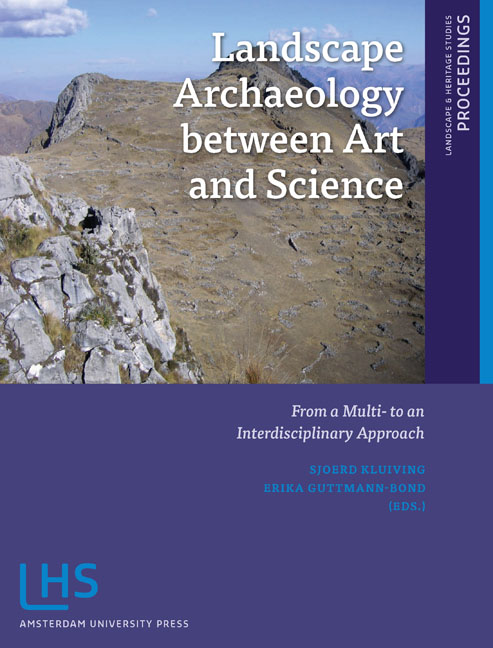Book contents
- Frontmatter
- Contents
- Preface
- Introduction: LAC2010: First International Landscape Archaeology Conference
- THEME 1 HOW DID LANDSCAPE CHANGE?
- THEME II IMPROVING TEMPORAL, CHRONOLOGICAL AND TRANSFORMATIONAL FRAMEWORKS
- THEME III LINKING LANDSCAPES OF LOWLANDS TO MOUNTAINOUS AREAS
- THEME IV APPLYING CONCEPTS OF SCALE
- THEME V NEW DIRECTIONS IN DIGITAL PROSPECTION AND MODELLING TECHNIQUES
- THEME VI HOW WILL LANDSCAPE ARCHAEOLOGY DEVELOP IN THE FUTURE?
- Miscellaneous Endmatter
4.1 - Landscape Scale and Human Mobility: Geoarchaeological Evidence from Rutherfords Creek, New South Wales, Australia
Published online by Cambridge University Press: 21 January 2021
- Frontmatter
- Contents
- Preface
- Introduction: LAC2010: First International Landscape Archaeology Conference
- THEME 1 HOW DID LANDSCAPE CHANGE?
- THEME II IMPROVING TEMPORAL, CHRONOLOGICAL AND TRANSFORMATIONAL FRAMEWORKS
- THEME III LINKING LANDSCAPES OF LOWLANDS TO MOUNTAINOUS AREAS
- THEME IV APPLYING CONCEPTS OF SCALE
- THEME V NEW DIRECTIONS IN DIGITAL PROSPECTION AND MODELLING TECHNIQUES
- THEME VI HOW WILL LANDSCAPE ARCHAEOLOGY DEVELOP IN THE FUTURE?
- Miscellaneous Endmatter
Summary
ABSTRACT
The surface archaeological record is abundant in some parts of arid Australia and, if analysed with attention to the history of deposition, it provides an accessible resource with which to assess past landscape use. Here, we report results of studies of the mid-late Holocene Aboriginal occupants of one part of the Australian arid zone, based on analyses of the archaeological record in the 62 km2 catchment of Rutherfords Creek in western New South Wales (NSW). We consider the types of behavioural information that can be derived from this record and how interpretation varies when considering different spatial and temporal scales. Those hunter-gatherers, who were highly mobile, traversed areas that were orders of magnitude larger than the areas that can be studied in detail by archaeologists. This requires the development of techniques for inferring the extent of landscape use from isolated spatial and temporal samples. We describe some of these techniques and consider the implications of the results obtained from their application.
INTRODUCTION
The arid regions of western NSW Australia have an abundant archaeological record that is highly visible due to the significant loss of topsoil caused by overgrazing since the late 19th century. Erosion has exposed stone artefacts and the remains of heat retainer hearths that are the legacy of intermittent occupation by Aboriginal people stretching back into the Late Pleistocene. An extensive, visible archaeological record, where stone artefacts and hearths reflect people's presence in the landscape, offers the opportunity for understanding mobility within a settlement system. However, the temptation to study mobility via a ‘dots on maps’ approach, i.e. where a map of recorded archaeological remains is interpreted directly as the outcome of the spatial scale of past human behaviour, runs into obvious logistic problems. Australia, for example, has almost the same landmass as the whole of Europe, meaning that geographic regions span areas that incorporate several of the smaller European nation states. It is not feasible to study the archaeological record left by people who, through time, might have traversed thousands of square kilometres. The first aim of this study is, therefore, to consider archaeological approaches that do not require the a priori definition of the geographic boundaries of the region used by hunter-gatherers when considering settlement systems.
- Type
- Chapter
- Information
- Landscape Archaeology between Art and ScienceFrom a Multi- to an Interdisciplinary Approach, pp. 279 - 294Publisher: Amsterdam University PressPrint publication year: 2012
- 1
- Cited by



